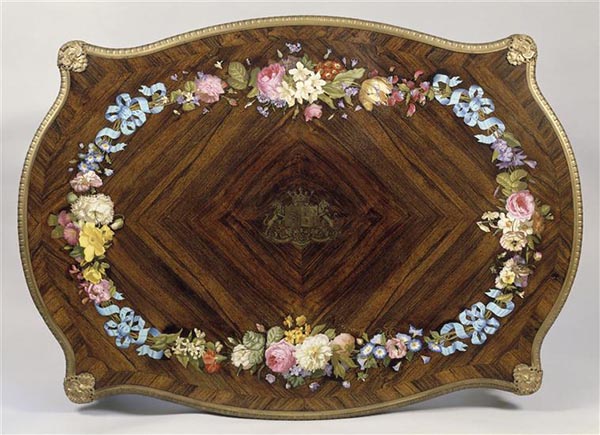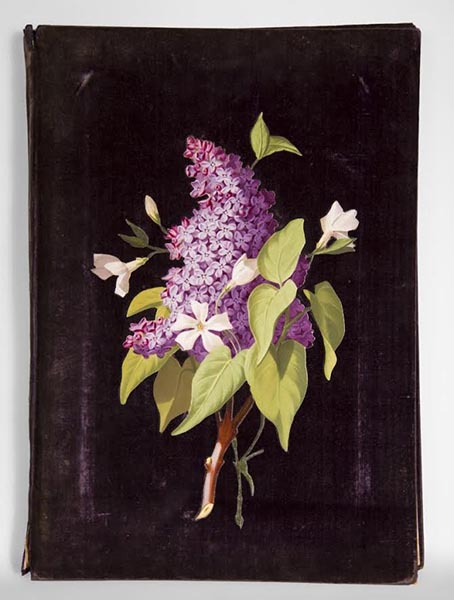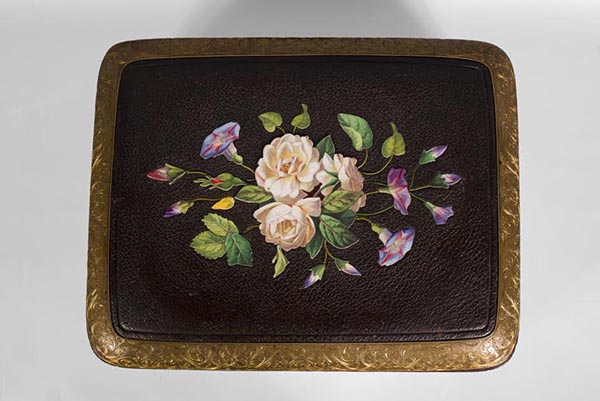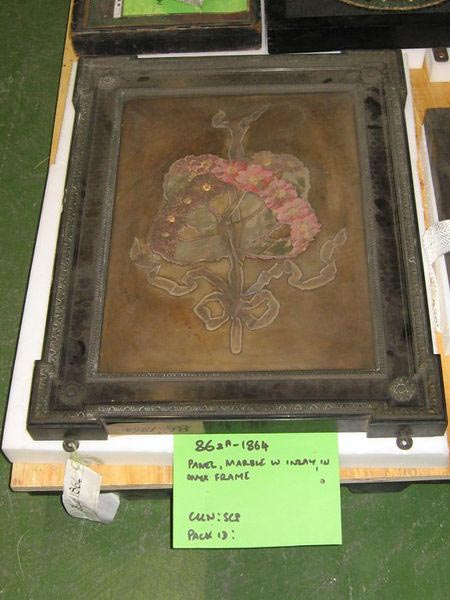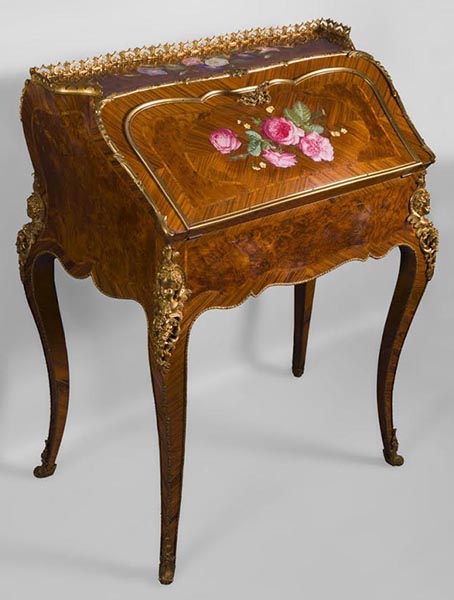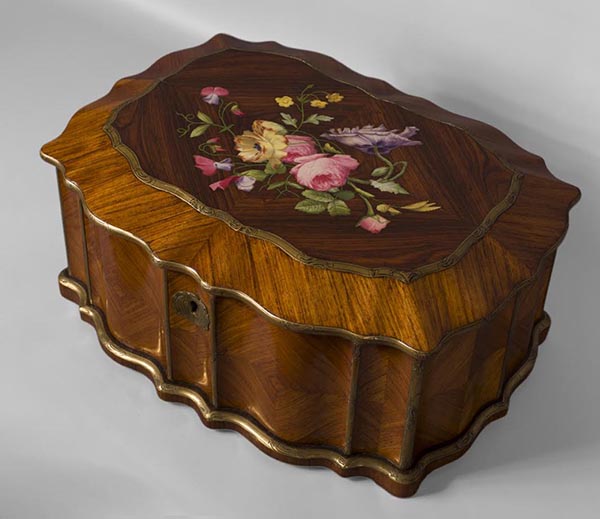Julien-Nicolas Rivart
Download PDFAn important cabinetmaker and painter on porcelain of the Second Empire, Julien-Nicolas Rivart, was born on July 1, 1802, or rather on 12 Messidor of the year 10, in the Paris of Napoleon I. The beginnings of his life have left no trace, so one assumes years of training in a modest environment. Paris was then shaken economically by the Revolution and the Napoleonic wars. For cabinetmakers, it was a time of important restrictions imposed by the embargo, which favored the use of local woods, typical of the Restoration style.
The first information that reached us seem to confirm these humble beginnings, for we find Rivart only in 1835, in a workshop of the popular quarters, located at number 76 rue du Faubourg Saint-Martin. He moved his workshop twice, in 1837 to 6 rue Sanson and in 1840 to 16 rue de la Folie Méricourt, perhaps reflecting difficulties in establishing his clientele. In his own words, these years were those of "sacrifices of every kind," "a perseverance of twenty years."
It was in 1848 that he developed a new marquetry technique and suddenly stepped into the limelight. A page of his life turned, at the same time that Louis-Napoleon Bonaparte took the reins of power. The Second Empire, proclaimed shortly afterwards, will see the country modernize considerably and the art industries thrive. The embargo lifted, the exotic woods resurface for the delight of luxury manufactures.
On September 18, 1849, Rivart registered his 15-year patent for "a type of inlay that can be done in wood lacquered or not, copper, marble, and any other stone, as well as on velvet, etc." Under this general heading, he aims at a material that had never been used in marquetry: porcelain. "All the research that has been done to date in this kind of industry has been unsuccessful and ... I first made this discovery," he says in the memorandum accompanying his patent. He fiercely defended the paternity of his invention, patenting all subsequent improvements.
Thanks to this process of which he had the intuition, he is propelled to the front of the stage of decorative arts. With his technique, porcelain can be added without taking up more space than necessary, not to hide the beauty of the wood. This invention, of which he defended the property, opens the doors of collaborations with important artists, and thus gain access to prestigious orders. The most important will be Tahan , cabinetmaker of the Emperor, but he also collaborates with Alphonse Giroux . His studio is now 1 rue de Normandie, in a dynamic district of old Paris.
The World’s Fairs will be extremely profitable to Rivart. He had his idea just in time to participate in these international meetings initiated by Prince Albert in London in 1851. For this historic event, he enjoys the collaboration of Victor Paillard, a sculptor precisely responsible for supervising the statue of the Queen Victoria. The two artists thus presented an imposing cabinet made of ebony and mahogany, which put to their advantage porcelain painting, its shadows and its clarity. The furniture is bought by the Duke de Caumont de La Force and receives sixteen medals, including the Prize medal.
Noticed, therefore, at the World’s Fair of 1851 , he is lauded at the second, which took place in 1855 in Paris, in response to the English innovation. Rivart associated with the great Tahan Manufactory, and with the painter from Sèvres Manufactory Pierre-Joseph Guérou, nearly twenty years his junior. Critics promote him :
"A very ingenious innovation was brought by Rivart in furniture inlay: it consists in the application of cut-out painted porcelain which thus forms pictures of flowers and which in certain cases replace the usual mosaic of wood, allowing to entrust distinguished artists with the decoration of furniture ". In particular, his cabinet with three panels "of a very beautiful artistic effect" is underscored.
He displayed in this important exhibition rosewood furniture and a table in black marble, which earned him a first-class medal. His stand was noticed by the Imperial couple, from whom he received compliments, and the Empress Eugenie de Montijo then acquired a Jewel Case, now in the Museum of Compiègne.
After the World’s Fair of 1855 , Rivart was regularly solicited for important commissions. Thus, two years later, in 1857, Tahan delivers a table ornamented with porcelain inlays at the Tuileries Palace. In 1861, Rivart created a table for Count Charles André de Manneville, today at the Cité de la Céramique of Sèvres, and the following year he contributed to the development of the French Imperial Commission for the 1862 exhibition.
At that date, Rivart exports 50% of its production. One must see here the effect of the World’s Fairs , which gave him an international showcase. In particular, he supplied his marquetry to Frédéric Roux, a Parisian cabinetmaker who knew the American market well for having worked in New York.
Julien-Nicolas Rivart died on February 17, 1867 without being able to finish the marble panels encrusted with porcelain which he was preparing for the Universal Exhibition in Paris the same year. Frédéric Roux presents them on his behalf, but the absence of the inventor is noticed. Auguste Luchet, a writer of his generation, witnessed this disappearance and predicted: "No one will ever do what he did."
Indeed, the delicacy of Rivart's work for the inlay of porcelain never found an equal to take over. The furniture inlaid with porcelain marquetry remain rare pieces, witnesses of the inventiveness of the second half of the nineteenth century. In 1900, the Universal Exhibition, which traced the "record of the century", does not forget the favor that Rivart porcelain had gained during the Second Empire, exposing one of his tables in the Salon Napoleon III.
Julien-Nicolas Rivart, the only one to have succeeded where others had failed to realize an innovative marquetry, left the traces of his obstinacy, his determination. Sure of his skill and talent, he pulled himself out of the crowd and made the world recognize him.
Bibliography
Marc Maison et Emmanuelle Arnauld, Marqueteries virtuoses au XIXe siècle : Brevets d'invention. Rivart, Cremer, Fourdinois, Kayser Sohn et Duvinage, Dijon, Faton, 2012.
Découvrez notre site dédié à Nicolas Rivart et ses créations









